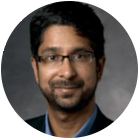Data Science for Human Health
It is clear that data science will be a driving force in transitioning the world’s healthcare systems from reactive “sick-based” care to proactive, preventive care.
First, and most importantly, data science has the power to empower the consumer, giving them more control over their own care. People can make better, more informed decisions if their care providers are able to make better, more data-based recommendations. Imagine your care provider could access your genetic information in a proactive healthcare system, measure your genetic risk for disease—not just as an individual but also as a member of a larger population—and then help you manage that risk throughout your life course.
This is the kind of personalized, patient-focused medicine that current reactive healthcare systems cannot facilitate, because they are designed to wait until things go wrong with the human body before addressing the problem, and every individual is deemed responsible for managing his/her own health and risk. In a data-based proactive healthcare system, public education could inform people of what it means to have different levels of risk. Since we all carry some level of risk (some more than others for specific diseases), individuals could be informed of their individual and collective health risks early on, enhancing control over their own health at every stage of their lifespan.
Second, data science enables more cost-effective drug discovery, helping us do the right thing for the right person. Rather than have someone trying and failing ten different drugs at great expense to the individual and the acute-based care system (not to mention worsening quality of life for the patient), data science can help us choose the right one on the first try. Although that drug in isolation is more expensive for the system, it would have been even more expensive if we didn’t have data science because that person would have had ten different things tried and failed. Additionally, data science allows us to bring things to market more quickly, because we’re not beholden to the hypothesis-driven routine.
Third, data science technologies are capable of improving patient outcomes and conditions with variable outcomes. They can capture data inputs, weed out subtypes, and distill best practices when combating disease, such as brain or other neurological cancers.
Lastly, data science technology can also reconfigure the costs associated with delivery of care by utilizing continuous data capture, analytics, and new key insights in order to inform physicians and clinicians when things have gone wrong in the human body before patients feel unwell. That understanding could then be integrated into a new model of care, which would enable early intervention, thus preventing that individual from having to go to the hospital. Recent Stanford research has begun to explore the possibilities of monitoring cardiomyopathy patients at home and monitoring children in the ER and ICU: we believe these studies are leading us toward a future of proactive, consumer-based care.
We recognize fully that technological advancement and unprecedented growth in biomedical data have created great opportunities, but they have also introduced great challenges for protecting the privacy and security of patient and other research data. We must work with stakeholders and experts in the private sector and federal agencies, such as the NIH, to promote and practice robust and proactive information-security procedures to ensure appropriate stewardship of patient and research-participant data while at the same time enabling scientific and medical advances.
People
Contributors
- Medicine, Genetics, & Biomedical Science
- Adjunct Professor
- Computer Science
- Bioengineering
- Stanford W. Ascherman Professor of Genetics





